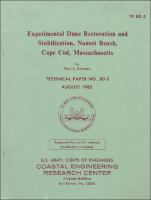Please use this identifier to cite or link to this item:
https://hdl.handle.net/11681/22208Full metadata record
| DC Field | Value | Language |
|---|---|---|
| dc.contributor.author | Knutson, Paul L. | - |
| dc.date.accessioned | 2017-05-08T16:28:54Z | - |
| dc.date.available | 2017-05-08T16:28:54Z | - |
| dc.date.issued | 1980-08 | - |
| dc.identifier.uri | http://hdl.handle.net/11681/22208 | - |
| dc.description | Technical Paper | en_US |
| dc.description.abstract | Abstract: In April 1970, experimental plots were established on a baymouth bar at Nauset Harbor on Cape Cod, Massachusetts. On the bar both sand fences and American beachgrass (Amrnophila breviligulata) were tested as alternative techniques for creating and stabilizing dunes. Elevational profiles were made periodically in the test plots from April 1970 to November 1977. The study concluded that sand fences initially capture sand more rapidly than newly planted beachgrass. Once established, however, beachgrass plantings trap sand at a rate equivalent to multiple lifts of sand fence. Using either sand fence or beachgrass, a dune growth rate of more than 11 cubic meters per linear meter of beach per year was sustained. Crest elevation increased 0.25 meter per year. | en_US |
| dc.language.iso | en_US | en_US |
| dc.publisher | Coastal Engineering Research Center (U.S.) | en_US |
| dc.publisher | Engineer Research and Development Center (U.S.) | en_US |
| dc.relation.ispartofseries | Technical Paper;no. 80-5 | - |
| dc.rights | Approved for public release; distribution is unlimited. | - |
| dc.source | This Digital Resource was created from scans of the Print Resource. | - |
| dc.subject | Beach erosion | en_US |
| dc.subject | Grasses | en_US |
| dc.subject | Sand dunes | en_US |
| dc.title | Experimental dune restoration and stabilization, Nauset Beach, Cape Cod, Massachusetts | en_US |
| dc.type | Report | - |
| Appears in Collections: | Technical Paper | |
Files in This Item:
| File | Description | Size | Format | |
|---|---|---|---|---|
| CERC Technical Paper No 80-5.pdf | 5.44 MB | Adobe PDF |  View/Open |